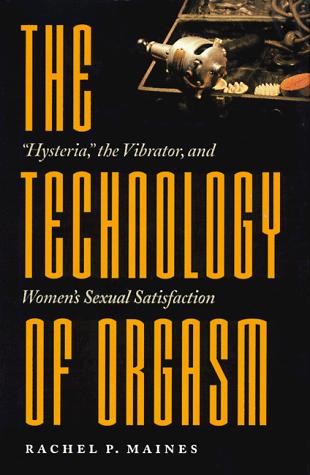Rachel P. Maines: The Technology of Orgasm: “Hysteria”, the Vibrator, and Women’s Sexual Satisfaction (2001)
Filed under book | Tags: · advertising, history of technology, hysteria, sex, technology, vibrator, women

From the time of Hippocrates until the 1920s, massaging female patients to orgasm was a staple of medical practice among Western physicians in the treatment of “hysteria,” an ailment once considered both common and chronic in women. Doctors loathed this time-consuming procedure and for centuries relied on midwives. Later, they substituted the efficiency of mechanical devices, including the electric vibrator, invented in the 1880s. In The Technology of Orgasm, Rachel Maines offers readers a stimulating, surprising, and often humorous account of hysteria and its treatment throughout the ages, focusing on the development, use, and fall into disrepute of the vibrator as a legitimate medical device.
Publisher JHU Press, 2001
Johns Hopkins studies in the history of technology
ISBN 0801866464, 9780801866463
208 pages
PDF (no OCR; updated on 2012-10-23)
Comment (0)Ellen Lupton: Mechanical Brides: Women and Machines from Home to Office (1993)
Filed under book | Tags: · advertising, graphic design, machine, marketing, technology, women

During the 20th century, the marketing of domestic appliances and office machines has been directed primarily toward women. Mechanical Brides examines this phenomenon through extensive graphics (advertisements, catalog pages, photographs) and analytical text.
Publisher Princeton Architectural Press, 1993
ISBN 1878271970, 9781878271976
65 pages
PDF (no OCR, updated on 2012-9-21)
Comment (0)Jane Margolis, Allan Fisher: Unlocking the Clubhouse: Women in Computing (2003)
Filed under book | Tags: · computer games, computing, gender, hacker culture, history of computing, history of technology, technology, women

“The information technology revolution is transforming almost every aspect of society, but girls and women are largely out of the loop. Although women surf the Web in equal numbers to men and make a majority of online purchases, few are involved in the design and creation of new technology. It is mostly men whose perspectives and priorities inform the development of computing innovations and who reap the lion’s share of the financial rewards. As only a small fraction of high school and college computer science students are female, the field is likely to remain a “male clubhouse,” absent major changes.
In Unlocking the Clubhouse, social scientist Jane Margolis and computer scientist and educator Allan Fisher examine the many influences contributing to the gender gap in computing. The book is based on interviews with more than 100 computer science students of both sexes from Carnegie Mellon University, a major center of computer science research, over a period of four years, as well as classroom observations and conversations with hundreds of college and high school faculty. The interviews capture the dynamic details of the female computing experience, from the family computer kept in a brother’s bedroom to women’s feelings of alienation in college computing classes. The authors investigate the familial, educational, and institutional origins of the computing gender gap. They also describe educational reforms that have made a dramatic difference at Carnegie Mellon—-where the percentage of women entering the School of Computer Science rose from 7% in 1995 to 42% in 2000—and at high schools around the country.”
Publisher MIT Press, 2003
ISBN 0262632691, 9780262632690
182 pages
PDF (updated on 2012-7-17)
Comment (0)
